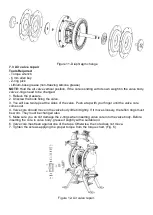
WARNING !
When you are transferring hazardous fluids or the pump temperature
is over 60C, operator must take safety precautions to drain the fluid.
WARNING !
FIRE AND EXPLOSION HAZARD
If you are working with flammable fluids, be sure to take precautions
around the pump while cooling it. You must vent the exhaust to a safe
place
WARNING !
Diaphragm pumps are sold as pump unit only. Installing a control
device (if needed) is responsibility of the operator.
If the power supply of the pump (compressor) is stopped, the air
inlet to the pump must be cut off immediately. Otherwise when
compressor restarts, pump may start unexpectedly.
Manual operation:
If the power supply of the pump (compressor)
is stopped, operator must cut off the air feed to the pump
manually. The operator must be informed and warned about this.
Automatic operation:
If the power supply of the pump
(compressor) is stopped, control unit must cut off the air feed to
the pump automatically. Installing this system is the responsibility
of the operator or the owner.
6.0. PUMP OPERATION INSTRUCTIONS
IMPORTANT NOTE
The pump has a variable temperature resistance to the
transferred fluid. The temperature resistance of the
diaphragm, balls and ball seats defines the temperature
resistance of the pump.
6.1. Flush the pump before use.
Pump is tested with water. Flush the pump with a proper solvent before use if your fluid is affected by
water. Follow the instructions in
Starting and Adjusting the Pump.
6.2 Starting and adjusting the pump
1- Check pump grounding before use.
2- Check fittings to be sure they are tight. Use a compatible liquid thread sealant (teflon, etc.) on
male threads. Tighten fluid inlet and outlet fittings securely.
3- Submerge the suction hose in the fluid.
Note: If the inlet fluid pressure is more than 25% of the outlet working pressure, ball check valves
will not close fast enough, result will be inefficient pump operation.
4- Place discharge hose in a suitable container.
5- Turn off the fluid drainage valve.
6- Turn the air regulator knob three quarters of a cycle clockwise, and open all bleed-type master air
valves.
7- Increase the air pressure slowly using the air regulator untill the pump primes. Set air regulator to
2 bar pressure. Operate the pump
slowly
until it is
fully loaded.
8- Working with thick fluids, operate the pump
very slowly
until it is fully loaded.
9- Pump is tested with water. If you need a clean pump in your process, flush the pump with suitable
fluid until it is fully clean. Then place the suction hose in the fluid container to be pumped.









































